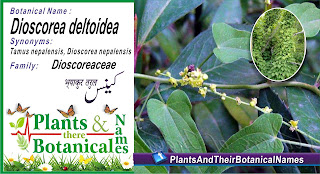Dioscorea deltoidea
Common name: Nepal Yam
Hindi: Shingli-mingli
persian : تمیس (سرده)
Common name: Nepal Yam
Hindi: Shingli-mingli
persian : تمیس (سرده)
Arabic: خيرون
Pashto: Kenas /کینس
اردو : کانس ، کینس , کلرری ، کنج ، کرتا
Baniatakari, Harvish, Janj, Jung kinch
Nepali: भ्याकुर तरुल Bhyakur tarul
Botanical name: [Dioscorea deltoidea Wall. ex Griseb.] Dioscorea deltoidea
Family: Dioscoreaceae (Yam family)
Synonyms: Tamus nepalensis, Dioscorea nepalensis
Dioscorea deltoidea, commonly known as Indian Yam or Chestnut Vine, is a species of yam belonging to the Dioscoreaceae family. It is a climbing perennial plant native to various parts of Asia, including India, Sri Lanka, Nepal, Bhutan, and Bangladesh. This plant is particularly found in forested areas, along streams, and on hillsides.
اردو : کانس ، کینس , کلرری ، کنج ، کرتا
Baniatakari, Harvish, Janj, Jung kinch
Nepali: भ्याकुर तरुल Bhyakur tarul
Botanical name: [Dioscorea deltoidea Wall. ex Griseb.] Dioscorea deltoidea
Family: Dioscoreaceae (Yam family)
Synonyms: Tamus nepalensis, Dioscorea nepalensis
Dioscorea deltoidea, commonly known as Indian Yam or Chestnut Vine, is a species of yam belonging to the Dioscoreaceae family. It is a climbing perennial plant native to various parts of Asia, including India, Sri Lanka, Nepal, Bhutan, and Bangladesh. This plant is particularly found in forested areas, along streams, and on hillsides.
Here are some key characteristics of Dioscorea deltoidea:
1. Appearance: Dioscorea deltoidea is a climbing vine that can reach lengths of several meters. It has heart-shaped leaves with three lobes, giving it the name "deltoidea" (meaning triangular) due to the leaf shape. The leaves are green and sometimes have a glossy texture.
2. Tuberous Roots: Like other yam species, Dioscorea deltoidea has tuberous roots that are the edible part of the plant. The yam tubers are starchy and have a nutty flavor, making them a valuable food source for local communities.
3. Distribution: As mentioned earlier, this species is native to South Asia, primarily found in countries such as India, Sri Lanka, Nepal, Bhutan, and Bangladesh. It prefers the warm and humid climates of tropical and subtropical regions.
4. Culinary Uses: The tubers of Dioscorea deltoidea are used as a food source in some regions. They can be boiled, roasted, or cooked in various dishes. The flavor and texture of the yam make it a popular ingredient in traditional cuisines.
5. Medicinal Uses: In traditional medicine, certain parts of the Dioscorea deltoidea plant, such as the tubers and leaves, are used for various medicinal purposes. They are believed to have potential health benefits, including anti-inflammatory and antioxidant properties.
6. Ecological Importance: Dioscorea deltoidea plays a role in the ecosystem as a climbing vine, providing habitat and support for other plant species. Additionally, the yam tubers serve as a food source for animals, contributing to the biodiversity of the region.
It's important to note that while Dioscorea deltoidea has edible tubers and potential medicinal uses, some yam species can be toxic if not properly prepared or identified correctly. Therefore, caution should be exercised when consuming any wild plant species, and it is recommended to seek guidance from local experts or authorities before using them for food or medicinal purposes.
https://web.facebook.com/PlantsAndTheirBotanicalNames
https://web.facebook.com/PlantsAndTheirBotanicalNames





No comments